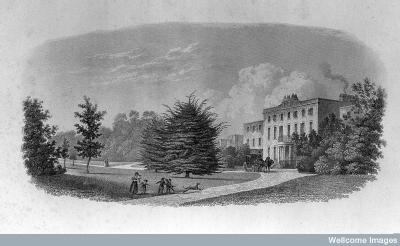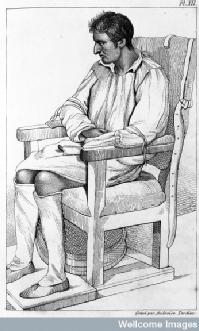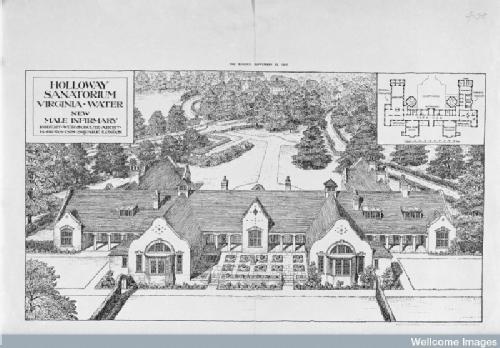Introduction: The Trade in Lunacy
Hilary Marland
The origins of private madhouses and the ‘trade in lunacy’ are vague and shadowy. However, this ‘fine trade’ had already taken hold in England by the Elizabethan period and shards of evidence survive relating to such business enterprises from the seventeenth century. By 1661 Reverend John Ashbourne was caring for lunatics in Suffolk, George Trosse was accommodated by a family near Glastonbury when he went mad in mid-century, and there were several small-scale madhouses scattered throughout London. By the eighteenth century, spurred on by a huge increase in the consumption of medical goods and services on a broader scale, the trade in lunacy entered its heyday. Private asylums proliferated throughout the country, set up by entrepreneurial individuals and families, some medically trained, many not. Some madhouse proprietors professed expertise in curing disorders of the mind; others were driven by the business opportunities the trade offered to anyone with the wherewithal to embark on such an enterprise: a small and secure house and a few pairs of hands to manage the patients.

Facade and gardens of Brislington House, 1836.
Families as well as overseers of the poor deposited patients in these small-scale institutions at a time when there was little alternative provision for the containment and treatment of mental disorder. Aside from a handful of charitable asylums and the infamous Bethlem Hospital in London, few provisions existed for the care of the mentally afflicted who were otherwise left to wander free, uncared for, or locked up in workhouses, attics or cellars. Some private madhouses catered for a mere handful of patients; Witney and Hook Norton in Oxfordshire took about a dozen patients and Drayton Parslow in Buckinghamshire, specialising in Oxford University breakdowns, had even smaller numbers. Others were much larger, such as London’s Hoxton House which had 486 patients by 1815 and Haydock Lodge Asylum, near Liverpool, which took similar numbers of chiefly pauper patients by the mid-nineteenth century. Ticehurst Asylum, set up by apothecary Samuel Newington in 1792, catered for affluent patients, charging large fees of around half a guinea a week, and offered high standards of comfort and extensive facilities (including plush rooms, a plethora of servants and riding to hounds for the male patients), while Brislington House, which opened in 1804, offered similar services to patients who included members of the nobility. Other private madhouses, however, were little better than ramshackle barns and outhouses. By the end of the eighteenth century there were around 45 recorded private madhouses in England and Wales, but the total is likely to have been much higher. Many of these were specialised:
One person informs you that his MAD-HOUSE is at your service; a second keeps a boarding-house for idiots; a good natured man-midwife pays the utmost attention to the ladies in certain situations, and promises to use the most scrupulous secrecy. (J.W. von Archenholz, A Picture of England: Containing a Description of the Laws, Customs and Manners of England (London: for the bookseller, 1797), p.156.)
The trade in lunacy was regarded as shady, secretive, as Roy Porter has put it, ‘in the business of preserving discreet silences’, and madhouses places to hide away eccentric, difficult or obstructive relatives, to resolve property disputes, to banish difficult wives and daughters. They have left few traces for the historian, tending not to keep case books and destroying their records. Porter has also described such institutions as both ‘sites of therapeutic innovation’ and ‘running sores of scandal’, reflecting, on the one hand, their positive attributes and efforts to cure and comfort their patients and, on the other, the extreme cruelties and deprivations which often characterised these institutions. Daniel Defoe was alert to the grievances of wrongful confinement and the ‘shark-like’ behaviour of the proprietors of private madhouses, and also described how the conditions in these institutions ‘clapped up, stripped, whipped, ill fed and worse used’ was ‘sufficient to drive any soul stark-staring mad’. ‘All private Mad-Houses should be suppressed at once’. In contrast, some institutions were run by kindly individuals with a genuine concern to improve the lot of the mentally disturbed or by doctors eager to develop greater expertise in treating lunacy, who published books based on their experiences. Fishponds Asylum, near Bristol, established by Baptist George Mason, appears to have been a humane establishment, with family members taking tea and holding prayers with patients. William Cowper was sent to Nathaniel Cotton’s private ‘Collegium Insanorum’ in St Albans in 1763, and expressed his relief at reaching such a safe haven.

An insane patient in a restraint chair in a French asylum, 1838. Similar equipment was also in use in private madhouses, and George III, while treated by Dr Francis Willis, was also confined in a similar chair.
I was not only treated with kindness by him when I was ill, and attended with the utmost diligence; but when my reason was restored to me, and I had so much need of a religious friend to converse with, to whom I could open my mind upon the subject without reserve, I could hardly have found a fitter person for the purpose. (William Cowper, Memoir of the Early Life of William Cowper, Esq. (London: R. Edwards, 1816), p.114).
Yet in an ‘amalgamation of function, rendering the physician simultaneously both medical advisor and hotelier’, there was always money to be made by extending the patient’s stay and
it requires no uncommon faith to believe, that the desire of profit and the accumulation of advantages resulting from expensive board and lodging, will, with too many, have more weight than the reputation of an early cure. (B. Faulkner, Observations on the General and Improper Treatment of Insanity (London: for the author, 1789), pp. 18-19.)

Holloway Sanatorium in 1906.
By the nineteenth century private asylums were catering not only for the very wealthy and the very poor, but also the middle class with Holloway Sanatorium being set up in Virginia Water, Surrey in 1885 by the millionaire proprietor of patent medicines, Thomas Holloway, to cater for what was envisaged to be a growing demand for care amongst those who would shudder to send their relatives to public asylums but who could not afford the high fees demanded by asylums for the rich, such as Ticehurst. Others treated patients brought back from India, their mental health destroyed by heat and isolation, or army and navy personnel who had broken down in military service. For much of the nineteenth century, private asylums continued to play a major part in mopping up the huge surplus of patients who could not be accommodated in the massive, but still overcrowded, county asylums that were being set up across the country. And private facilities have revived today as, faced by a shortage of psychiatric beds in the National Health Service, mental health patients are admitted in their thousands to private residential care homes, their care often supported directly by their families.
Further Reading:
• William Ll. Parry-Jones, The Trade in Lunacy: A Study of Private Madhouses in England in the Eighteenth and Nineteenth Centuries (London: Routledge & Kegan Paul, 1972).
• Roy Porter, Mind-Forg’d Manacles: A History of Madness in England from the Restoration to the Regency (London: Athlone, 1987; Penguin edn, 1990).
• Roy Porter (ed.), The Faber Book of Madness (London: Faber and Faber, 1991).
• Andrew Scull, The Most Solitary of Afflictions: Madness and Society in Britain, 1700-1900 (New Haven and London: Yale University Press, 1993).
